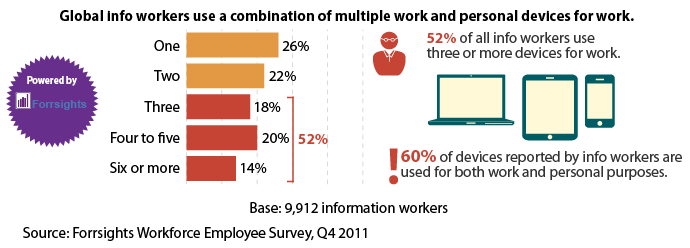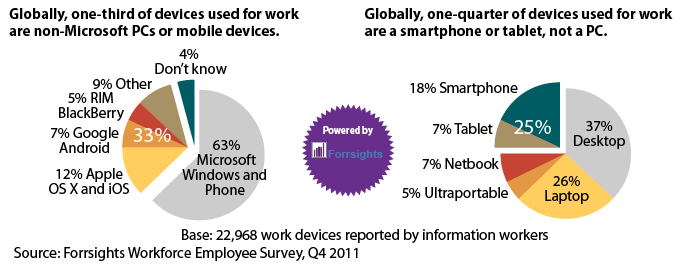Employees Use Multiple Gadgets For Work — And Choose Much Of The Tech Themselves
Employees that use smart devices — PCs or mobile devices — for work have expanded their use of technology more than most people realize. How many devices do you think a typical information worker uses for work? If you only ask the IT staff, the answer will be that most use just a PC, some use a smartphone, and a few use a tablet. But our latest Forrsights workforce employee survey asked more than 9,900 information workers in 17 countries about all of the devices they use for work, including personal devices they use for work purposes. It turns out that they use an average of about 2.3 devices.
About 74% of the information workers in our survey used two or more devices for work — and 52% used three or more! This means that the typical information worker has to figure out how to manage their information from more than one device. So they’ll be increasingly interested in work systems and personal cloud services that enable easy multidevice access, such as Dropbox, Box, SugarSync, Google Docs/Apps, Windows Live, and Apple iCloud.

When you dig into the data, the mix of devices info workers use for work is different than what IT provides. About 25% are mobile devices, not PCs, and 33% use operating systems other than Microsoft.

Think about that for a minute: Microsoft’s share of OSes on shipping PCs is still far above 90% and declining only incrementally in the face of growing Apple Mac share. Microsoft’s share of PCs in companies is even higher. But seen through the eyes of the workers, not IT, Microsoft is down to about two-thirds of the devices they use to get work done.
With the strong growth of mobile devices — personal or issued by IT — and Microsoft’s minuscule share of mobile devices, that means that Microsoft’s share of the OS on devices used for work will continue to erode.
Microsoft will continue to have the largest share of device OS by far, but it’s no longer the only game in town. And the buying dynamic has shifted: Info workers choose — and mostly pay for — 73% of the smartphones they use for work and 66% of the tablets. It turns out that they also choose, and mostly pay for, more than half of the laptops and even about one-quarter of the desktop PCs they use for work.
So Microsoft, and all purveyors of personal technology, will have to appeal much more to individuals to shape what technology is used at the office, rather than just sell to IT as they have in the past.
See our latest report, Info Workers Using Mobile And Personal Devices For Work Will Transform Personal Tech Markets, for a more detailed look at how information workers are bringing personal devices to work.